Balakumar Balachandran, Magrab E.B. Vibrations
Подождите немного. Документ загружается.

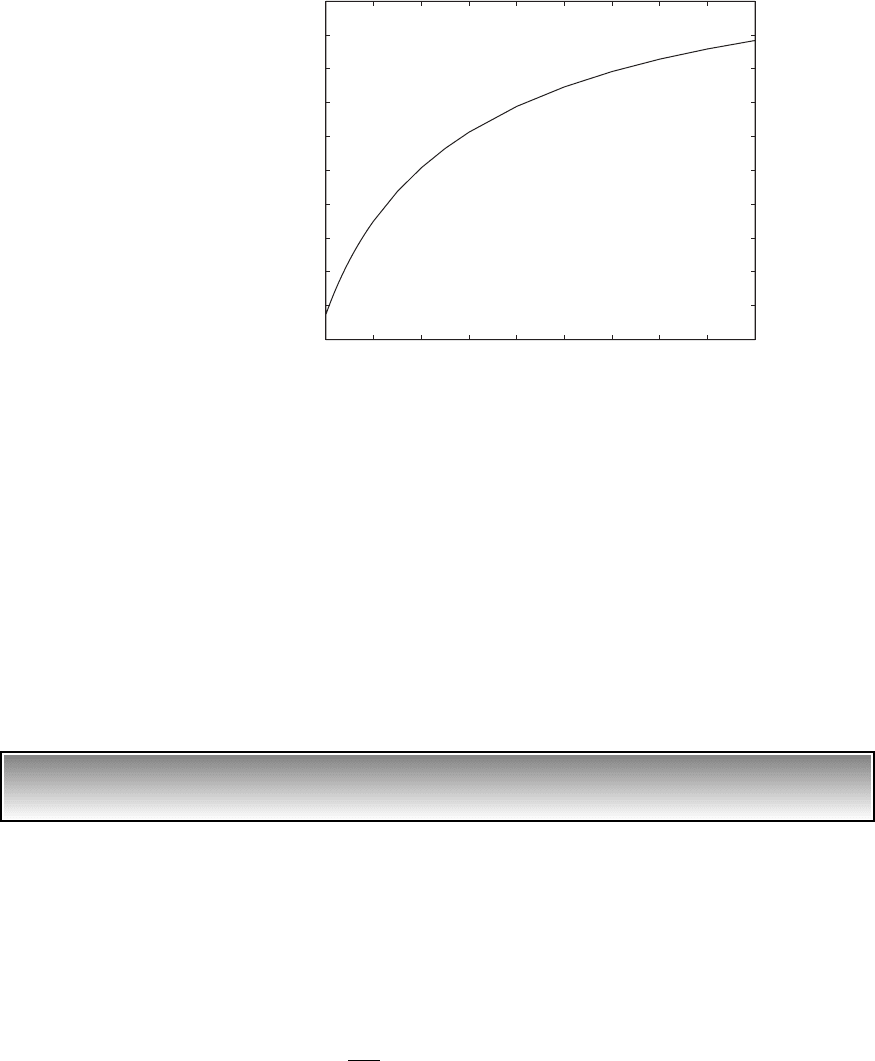
The first natural frequency coefficient determined from Eq. (c) is shown
in Figure 9.33 as a function of a, where
and l
1
is the lowest root of Eq. (c). Upon using Eq. (9.211) and Figure 9.33,
we see that a cantilever beam with a taper of a 0.667 (1/a 1.5) increases
the first natural frequency coefficient by 8.8% compared to that for a uniform
cantilever beam, whose first natural frequency coefficient is 1.875. (See
Case 4 in Table 9.3.) From Eq. (9.94), we see that this increases the natural
frequency by 18.4%.
EXAMPLE 9.6
Mode shape of a baseball bat
Let us consider a baseball bat-like beam, which shall be modeled as a tapered
beam that is free at each end. We shall determine the mode shape of this beam,
compare it to the mode shape of a uniform beam that is free at each end, and then
based on the results for the tapered beam make some judgments as to where one
should strike the ball. For the conical beam shown in Figure 9.32b, we have that
a b r
1
/r
o
1, where r
o
is the radius of the beam cross-section at h 1 and
r
1
is the radius of the beam cross-section at h 0. The taper functions a(h) and
i(h) given by Eqs. (9.212) are still applicable. In this case, Eqs. (9.213) become
(a)A
o
pr
2
o
I
o
pr
4
o
2
o1
l
1
11 a2
630 CHAPTER 9 Vibrations of Beams
1 2 3 4 5 6 7 8 9 10
1.8
1.9
2
2.1
2.2
2.3
2.4
2.5
2.6
2.7
2.8
1/a
Ω
o1
FIGURE 9.33
First natural frequency coefficient
for a double tapered cantilever
beam with a b.
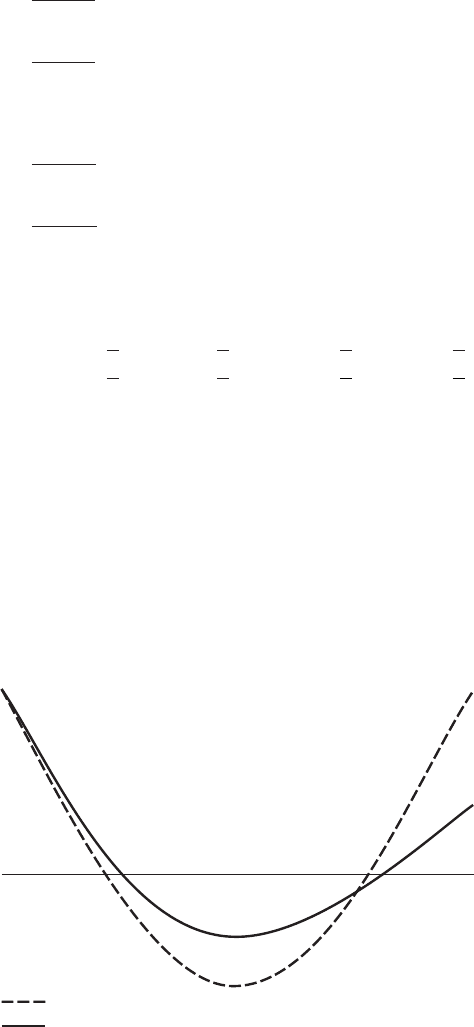
At the end h 1, which corresponds to w 1 from Eq. (9.215), we have the
boundary conditions
(b)
At the end h 0, which corresponds to w a, we have the boundary condition
(c)
On substituting Eq. (9.218) into the boundary conditions given by Eqs. (b)
and (c) and setting the determinant of the coefficients A
j
to zero, we obtain the
following equation
(d)
The evaluation of Eq. (d) for a taper ratio of a 1/2.2 0.4545 leads to
the frequency ratio
o1
4.081. This is lower than the value of
1
4.730
for a uniform beam free at each end obtained from Case 5 of Table 9.3. The
corresponding mode shape is shown in Figure 9.34 along with the mode shape
for the uniform beam. In the figure, the right-hand end of the beam is the fat-
ter end. It is seen that at the fatter end of the tapered beam, as the taper ratio
is increased the node point “moves” toward the end of the beam whereas, at
4
J
5
12l 1a2 Y
5
12l 1a2 I
5
12l 1a2 K
5
12l 1a2
J
4
12l 1a2 Y
4
12l 1a2 I
4
12l 1a2 K
4
12l 1a2
J
5
12l 2 Y
5
12l 2 I
5
12l 2 K
5
12l 2
J
4
12l 2 Y
4
12l 2 I
4
12l 2 K
4
12l 2
4 0
d
3
W1a 2
dw
3
0
d
2
W1a 2
dw
2
0
d
3
W11 2
dw
3
0
d
2
W11 2
dw
2
0
9.3 Free Oscillations 631
FIGURE 9.34
Comparison of the first mode shape
of a tapered beam with circular
cross-section with a 1/2.2 and a
uniform beam. The fatter end of the
tapered beam is at the right end.
Uniform beam
Tapered beam
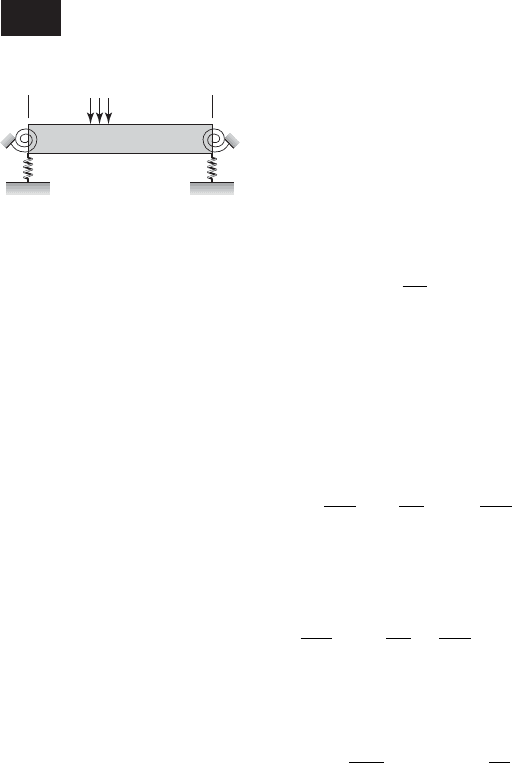
the thinner end, it moves toward the interior of the beam. In order for the beam
to act as a rigid member, at least as far as exciting the first mode shape, one
should strike the ball at the beam’s (bat’s) node point. That is, if the bat were
to strike the ball close to a node point of the first mode, then the first mode of
the bat will not be excited and there will be no energy transferred due to the
vibrations of the first mode of the bat. Usually, the so-called sweet spot of a
baseball bat is at the node of the first mode located near the fat end of the bat.
This tends to impart the maximum force to the ball, and frequently, the result
is that we hear it as the “crack” of the bat.
37
9.4 FORCED OSCILLATIONS
In Section 9.3, we studied the responses of different beam systems during free
oscillations. In this section, we shall study the response of beams to externally
applied dynamic transverse loading as shown in Figure 9.35. To solve for the
response, we shall use the normal mode approach and the technique of separa-
tion of variables. To simplify matters, we shall assume that the boundary con-
ditions are independent of time; that is, boundary conditions 9 and 10 in Table
9.1 will not be considered. We assume that the damping force is proportional to
the transverse velocity of the beam; that is, from Eq. (9.41c) we have
(9.219a)
where c has the units of Ns/m
2
.
Expressing the external loading f(x,t) as
(9.219b)
the equation of motion for the damped vibrations of the beam is obtained from
Eqs. (9.40) and (9.41c). Thus,
(9.220)
Governing Equations in Terms of Nondimensional Quantities
Employing the notation of Eqs. (9.67), Eq. (9.220) is rewritten as
(9.221)
where the nondimensional spatial variable h x/L, the nondimensional time
variable t t/t
o
,
(9.222)2z
ct
o
L
m
o
,
g1h,t 2
L
4
EI
f
d
1h,t 2
0
4
w
0h
4
2z
0w
0t
0
2
w
0t
2
g1h,t 2
EI
0
4
w
0x
4
c
0w
0t
rA
0
2
w
0t
2
f
d
1x,t 2
f 1x,t2 f
nc
1t 2 f
d
1x,t 2
f
nc
1t 2c
0w
0t
632 CHAPTER 9 Vibrations of Beams
37
R. K. Adair, “The crack-of-the-bat: the acoustics of a bat hitting the ball,” Paper No. 5pAA1,
141st Acoustical Society of America Meeting, Chicago, IL, June 2001.
k
2
k
1
k
t1
k
t2
f(x, t)
x 0 x L
FIGURE 9.35
Forced oscillations of a beam.

and z is the nondimensional damping factor, t
o
has the units of time, and
g(h,t) has the same units as w(h,t).
For the system shown in Figure 9.35, and making use of Eqs. (9.47), the
boundary conditions at h 0 are
(9.223)
and the boundary conditions at h 1 are
(9.224)
where B
j
and K
j
, j 1,2, are defined in Eq. (9.67). We recall that the form of
the boundary conditions given by Eqs. (9.223) and (9.224) have been chosen
so that we can examine a wide range of boundary conditions by independ-
ently varying the values of B
j
and K
j
, j 1, 2, from zero to infinity.
Solution for Response
To determine the response of the forced system described by Eqs. (9.221),
(9.223), and (9.224) and the specified initial conditions w w(h,0) and (h,0),
we make use of the mode shapes obtained from the free oscillation problem. For
the boundary conditions given by Eqs. (9.223) and (9.224), it is known from the
material of Section 9.3 that the mode shapes W
n
(h) are orthogonal functions, the
general form of which is given by Eqs. (9.89) or (9.91). In the present case, W
n
(h)
is a solution of the undamped system given by Eq. (9.70); that is,
(9.225)
with the boundary conditions at h 0 being
(9.226)
and those at h 1 being
(9.227)
The solution for the forced response of the system is assumed to be of
the form
(9.228)w1h,t 2
a
q
n 1
°
n
1t 2W
n
1h 2
W‡
n
11 2 K
2
W
n
11 2
W–
n
11 2B
2
W¿
n
11 2
W‡
n
10 2K
1
W
n
10 2
W–
n
10 2 B
1
W¿
n
10 2
d
4
W
n
dh
4
4
n
W
n
0
w
#
0
3
w11,t 2
0h
3
K
2
w11,t 2
0
2
w11,t 2
0h
2
B
2
0w11,t2
0h
0
3
w10,t 2
0h
3
K
1
w10,t 2
0
2
w10,t 2
0h
2
B
1
0w10,t2
0h
9.4 Forced Oscillations 633
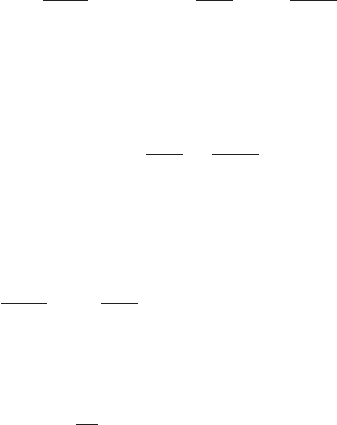
where W
n
(h) are determined from the spatial eigenvalue problem associated
with the undamped free oscillations of the system; that is, Eqs. (9.225) to
(9.227) and the summation are taken over the infinite number of modes. Since
W
n
(h) is a nondimensional quantity,
n
(t) has the same units as w(h,t). The
time-dependent functions
n
(t), also referred to as modal amplitudes, are un-
known quantities that remain to be determined.
We substitute Eq. (9.228) into Eq. (9.221) to obtain
(9.229)
where it is noted that due to the choice of the nondimensional variables each
term in Eq. (9.229) has displacement units. Upon substituting Eq. (9.225) into
Eq. (9.229) for the first term on the left-hand side, we obtain
(9.230)
We now multiply Eq. (9.230) by W
m
(h), integrate over the interval 0 h 1,
and use the orthogonality property expressed by Eq. (9.77) with M
o
J
o
0 to obtain
(9.231)
where
(9.232)
and G
n
(t) has displacement units and N
n
is a nondimensional quantity.
Equation (9.231), which governs the variation of the modal amplitude
n
(t), is similar to the equation governing a single degree-of-freedom system
discussed in Chapters 3 to 6. Therefore, the problem of determining the
forced response of the system has been reduced to the problem of solving for
the modal amplitudes
n
(t), each of whose governing equation is similar to
the equation governing a single degree-of-freedom system. The orthogonality
of the mode shapes is crucial to realizing this step.
Cases When a Mode Is Not Excited
On examining Eq. (9.231), it is clear that if G
n
(t) 0, then that particular
mode corresponding to
n
does not get excited by the forcing. This is possi-
ble in the following two cases. In the first case, we assume that the forcing is
acting at a point such that
N
n
1
0
W
2
n
1h 2dh
G
n
1t 2
1
N
n
1
0
W
n
1h 2g1h,t2dh
d
2
°
n
dt
2
2z
d°
n
dt
4
n
°
n
G
n
1t 2
n 1,2, . . .
a
q
n
c
4
n
°
n
2z
d°
n
dt
d
2
°
n
dt
2
dW
n
g1h,t 2
a
q
n1
c
d
4
W
n
dh
4
°
n
2zW
n
d°
n
dt
W
n
d
2
°
n
dt
2
d g1h,t2
634 CHAPTER 9 Vibrations of Beams

(9.233a)
Then, we obtain from Eqs. (9.232) that
(9.233b)
If h
1
is a node point, then W
n
(h
1
) 0 and G
n
(t) 0. To show this, we con-
sider a beam simply supported at each end. The mode shape is given by
Eq. (2b) of Table 9.2 and Case 2 of Table 9.3, and from Eq. (9.233b), G
n
(t)
becomes
which is zero at h
1
1/n, n 2, 3, . . . . Conversely, G
n
(t) is also zero, for
example, when h
1
0.5 and n 2, 4, . . . .
In the second case, we assume that the spatial distribution of the forcing
is such that
(9.234a)
Equation (9.234a) is satisfied when the forcing function is orthogonal to the
mode shape; that is, let
(9.234b)
where W
m
(h) is one of the orthogonal functions. In this case, we obtain from
Eqs. (9.232) that
(9.234c)
and, therefore, all the modal amplitudes are zero except for n m.
Solution for Response (continued)
The solution to Eq. (9.231) is obtained by using the Laplace transform, and
we follow the procedure used to obtain Eq. (D.11a) of Appendix D. In order
to make use of Eq. (D.11a), we rewrite Eq. (9.231) as
(9.235)
where
(9.236)z
n
z
2
n
d
2
°
n
dt
2
2z
n
2
n
d°
n
dt
4
n
°
n
G
n
1t 2
n 1,2, . . .
G
n
1t 2
1
N
n
1
0
W
n
1h 2F1t2W
m
1h 2dh F1t 2d
nm
g1h,t 2 F1t 2W
m
1h 2
1
0
W
n
1h 2g1h,t2dh 0
G
n
1t 2
F1t 2
N
n
sin1nph
1
2
G
n
1t 2
1
N
n
1
0
W
n
1h 2F1t2d1h h
1
2dh
F1t 2
N
n
W
n
1h
1
2
g1h,t 2 F1t 2d1h h
1
2
9.4 Forced Oscillations 635

The Laplace transform of Eq. (9.235) is given by Eq. (D.2) of Appendix D if
we identify
n
(t) with x(t), z with z
n
, v
n
with
2
n
, and we set F(s)/m (s).
Thus, if the Laplace transform of
n
(t) is (s), then in the Laplace domain
we have
(9.237)
where the overdot indicates the derivative with respect to t and the modal ini-
tial conditions are given by
n
(0) and (0). Making use of Eq. (9.228),
these initial conditions are determined from
(9.238)
where
If we multiply each of Eqs. (9.238) by W
m
(h), integrate over the interval
0 h 1, and make use of Eq. (9.77) with M
o
J
o
0, we obtain the modal
initial conditions
(9.239)
Assuming that 0 z
n
1, the inverse transform of Eq. (9.237) is ob-
tained from Eq. (D.11a) as
(9.240)
where
n
(t) is the nth modal amplitude and
(9.241)
is the damped natural frequency coefficient associated with the nth mode.
2
nd
2
n
21 z
2
n
1
2
nd
t
0
e
zt¿
sin 1
2
nd
t¿ 2G
n
1t t¿ 2dt¿
°
n
1t 2 °102e
zt
cos1
2
nd
t2
°
#
10 2 z°10 2
2
nd
e
zt
sin 1
2
nd
t2
°
#
n
10 2
1
N
n
1
0
W
n
1h 2w
#
1h,0 2dh
n 1,2, . . .
°
n
10 2
1
N
n
1
0
W
n
1h 2w1h,02dh
n 1,2, . . .
w
#
1h,0 2
1
t
o
dw1h,0 2
dt
w
#
1h,0 2
a
q
n1
°
#
n
10 2W
n
1h 2
w1h,0 2
a
q
n1
°
n
10 2W
n
1h 2
°
ˆ
n
°
ˆ
n
1s 2
G
ˆ
n
1s 2 1s 2z
n
2
n
2°
n
10 2 °
#
n
10 2
s
2
2z
n
2
n
s
4
n
°
ˆ
n
G
ˆ
n
636 CHAPTER 9 Vibrations of Beams

Forced Response in the Damped Case
Upon using Eqs. (9.228), (9.232), and (9.240), the displacement of the beam is
(9.242a)
The first term inside the brackets is the forced response in the nth mode and
the second and third terms are the responses of the nth mode to the initial con-
ditions. Making use of Eqs. (9.67) and (9.222), we can rewrite Eq. (9.242a) in
terms of the dimensional quantities as
(9.242b)
where
and
Forced Response in the Undamped Case
When the damping is absent, Eq. (9.242a) simplifies to
(9.243a) cos
1
n
2
t2
1
0
W
n
1h 2w1h,02dh
sin1
n
2
t2
n
2
1
0
W
n
1h 2w
#
1h,0 2dh d
w1h,t 2
a
q
n1
W
n
1h 2
N
n
c
1
n
2
t
0
c
1
0
g1h,t t¿ 2W
n
1h 2sin 1
n
2
t¿ 2dh ddt¿
z¿ z/t
o
v
dn
v
n
21 z
2
n
e
z¿t
sin 1v
dn
t2
v
dn
L
0
W
n
1x/L 2e
0w1x,02
0t
z¿w1x,02fdxd
e
z¿t
cos 1v
dn
t2
L
0
W
n
1x/L 2w1x,02dx
w1x,t 2
a
q
n
W
n
1x/L 2
LN
n
c
L
4
v
dn
t
2
o
EI
t
0
e
L
0
e
z¿t¿
sin 1v
dn
t¿ 2f
d
1x,t t¿ 2W
n
1x/L 2dx fdt¿
e
zt
sin 1
2
nd
t2
2
nd
1
0
W
n
1h 25w
#
1h,0 2 zw1h,026dh d
e
zt
cos 1
2
nd
t2
1
0
W
n
1h 2w1h,02dh
w1h,t 2
a
q
n1
W
n
1h 2
N
n
c
1
2
nd
t
0
e
1
0
e
zt¿
sin1
2
nd
t¿ 2g1h,t t¿ 2W
n
1h 2dh fdt¿
9.4 Forced Oscillations 637

In terms of the dimensional quantities, we rewrite Eq. (9.219b) as
(9.243b)
Equation (9.242a) describes the forced response of the system governed
by Eqs. (9.221) to (9.224) and the specified initial conditions, and they have
been expressed as a sum of the responses of the individual modes. In practice,
the infinite sum shown in Eq. (9.242a) is replaced by a finite number of terms,
with this number depending on the frequency content of the excitation.
EXAMPLE 9.7
Impulse response of a cantilever beam
We shall determine the displacement response of an undamped cantilever
beam that is initially at rest and subjected to an impulse force at h j x
1
/L.
In this case, c 0 in Eq. (9.220) and z 0 in Eq. (9.221). Since the beam
is initially at rest, the initial conditions are
(a)
and the forcing is expressed as
(b)
Upon substituting Eqs. (a) and (b) into Eq. (9.243a), and carrying out the in-
tegration, we find that
(c)
Upon using Eqs. (9.243b), we rewrite Eq. (c) in terms of the dimensional
quantities as
(d)
where f
o
is the magnitude of the impulse at x x
1
in N s.
The values of
n
are given in Case 4 of Table 9.3. The modes W
n
(h) are
given by Eq. (4b) of Table 9.2. The beam displacement given by Eq. (c) is plot-
ted in Figure 9.36 for impulses applied at h
1
0.4 and h
1
1. In each case,
the displacement pattern is shown at different instances of the nondimen-
sional time t. Each beam displacement was obtained after truncating the sum-
mation to 11 modes in Eq. (c).
#
w1x,t 2
f
o
L
3
t
2
o
EI
a
q
n1
W
n
1x/L 2W
n
1x
1
/L 2
N
n
v
n
sin 1v
n
t2
w1h,t 2 g
o
a
q
n1
W
n
1h 2W
n
1j 2
N
n
2
n
sin 1
2
n
t2
g1h,t 2 g
o
d1h j 2d1t2
w1h,0 2 w
#
1h,0 2 0
cos 1v
n
t2
L
0
W
n
1x/L 2w1x,02dx
sin 1v
n
t2
v
n
L
0
W
n
1x/L 2
0w1x,02
0t
dx d
w1x,t 2
a
q
n1
W
n
1x/L 2
LN
n
c
L
4
v
n
t
2
o
EI
t
0
e
L
0
sin 1v
n
t¿ 2f
d
1x,t t¿ 2W
n
1x/L 2dx fdt¿
638 CHAPTER 9 Vibrations of Beams
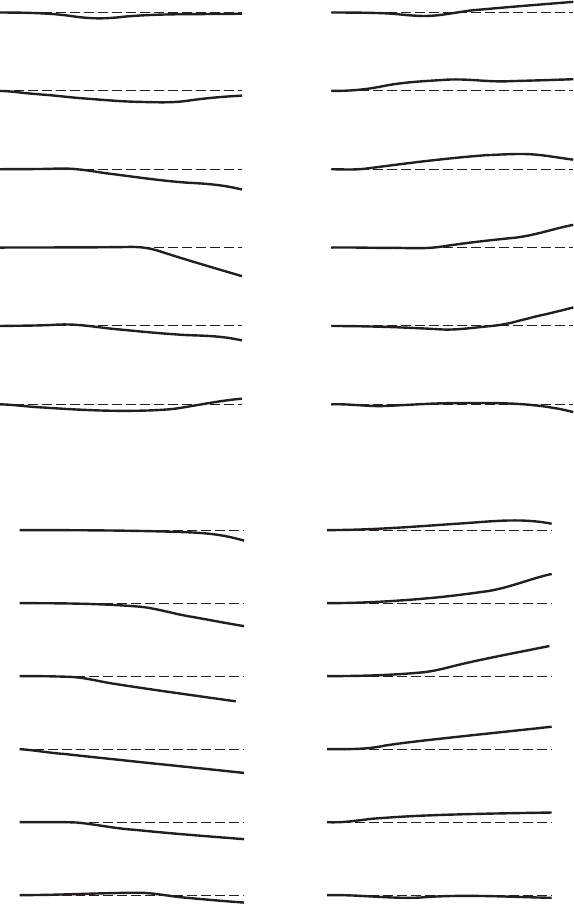
(a)
(b)
0.1
0.4
0.7
1
1.3
1.6
1.9
2.2
2.5
2.8
3.1
3.4
0.1
0.4
0.7
1
1.3
1.6
1.9
2.2
2.5
2.8
3.1
3.4
FIGURE 9.36
Normalized response of a cantilever beam subjected to an impulse force:
(a) h
1
0.4 and (b) h
1
1.
